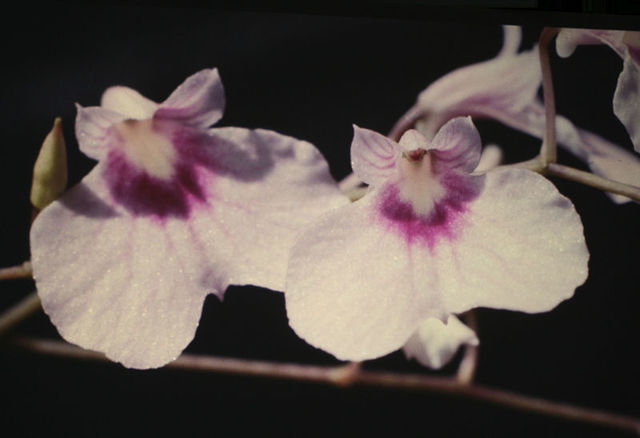These cute little miniatures are found from Florida through Bolivia and most of the Caribbean Islands. There are currently about ten species listed and most of them are twig epiphytes or tree growing orchids which need higher light and very quick drying conditions. It is listed as endangered by the USDA so if you ever see one in the wild you are very lucky.
They are similar in growth habit to Tolumnia and need much the same conditions. In general they are warm to hot growing and need year round water and fertilizer to encourage blooming in late spring and during the summer months. As you could see from the pictures, this little plant will put on a spectacular show from a mature plant when well grown. Most people grow it mounted on tree fern or cork so that he flowers can be well displayed as the branched inflorescences fall with the weight of the flowers. As with others that grow in this manner, watch out for spider mites and scale insects as they can hide in the crevasse and can kill the plants quickly.
The three main species grown are Ionopsis utricularioides, Ionopsis satyrioide and Ionopsis paniculata. There is some disagreement as to whether the last is a synonym (or the same species) as utricularioides but the flowering habit is different enough that we’ll address them separately here.
The most spectacular, without doubt, is Ionopsis utricularioides. It can be found from Mexico through Central America and occasionally on the Caribbean Islands and in South Florida. The flowers range from white to dark purple depending upon the cultivar. The branched inflorescence can reach three feet (or approximately 90 centimeters) with a hundred flowers. They are generally grown on small mounts and needs somewhat more shade than the Tolumnias. They need very good air circulation and high humidity year round. Intermediate temperature conditions of 80-85 degrees Fahrenheit, or 26-29 Centigrade, are recommended with a cooling at night of approximately 15 degrees Fahrenheit, or 9.5 Centigrade. The flowers are considered to be long blooming and will provide you with a great show. This is a plant that can be grown in Wardian cases since it remains in the 6 inch or 15 centimeter size range.
Ionopsis satyrioide has a smaller and less spectacular flowering habit, but you can easily see where the name “Violet Orchid” came from when you see it flowering. The flower is generally white with pink or purple striping. Culture is similar to utricularioides.
